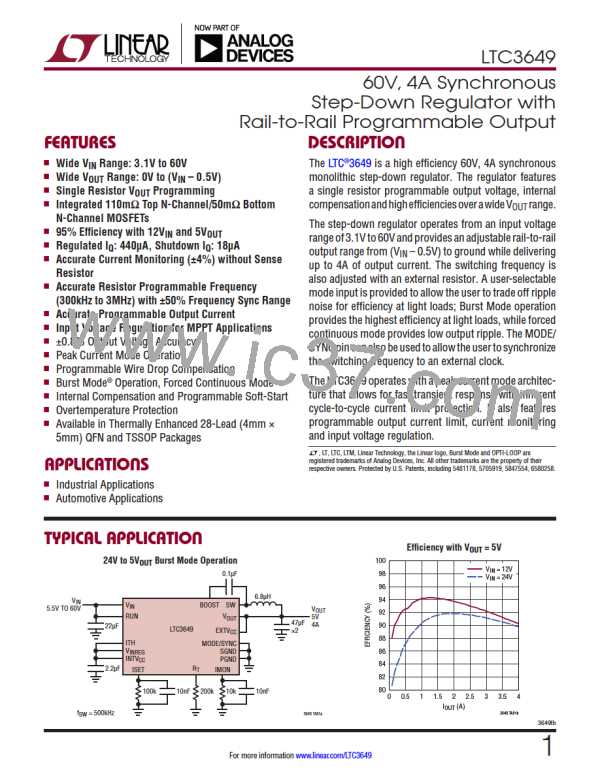LTC3649
APPLICATIONS INFORMATION
Input Capacitor (C ) Selection
important to only use types that have been surge tested
foruseinswitchingpowersupplies.Aluminumelectrolytic
capacitors have significantly higher ESR, but can be used
in cost-sensitive applications provided that consideration
is given to ripple current ratings and long-term reliability.
CeramiccapacitorshaveexcellentlowESRcharacteristics
and small footprints.
IN
The input capacitance, C , is needed to filter the square
IN
wave current at the drain of the top power MOSFET. To
prevent large input voltage droops from occurring, a low
effective series resistance (ESR) input capacitor sized for
themaximumRMScurrentshouldbeused.Themaximum
RMS current is given by:
Using Ceramic Input and Output Capacitors
VOUT
V
IN
VOUT
IRMS ≅IOUT(MAX)
−1
V
Higher value, lower cost ceramic capacitors are now be-
coming available in smaller case sizes. Their high ripple
current, high voltage rating and low ESR make them ideal
for switching regulator applications. However, care must
be taken when these capacitors are used at the input and
output. When only a ceramic capacitor is used at the input
and the power is supplied by a wall adapter through long
wires, a load step at the output can induce ringing at the
input. At best, this ringing can couple to the output and
be mistaken as loop instability. At worst, a sudden inrush
of current through the long wires can potentially cause
IN
This formula has a maximum at V = 2V , where
IN
OUT
I
≅ I /2. This simple worst-case condition is com-
RMS
OUT
monlyusedfordesignbecauseevensignificantdeviations
do not offer much relief. Note that ripple current ratings
from capacitor manufacturers are often based on only
2000 hours of life which makes it advisable to further de-
rate the capacitor, or choose a capacitor rated at a higher
temperature than required. Several capacitors may also
be paralleled to meet size or height requirements in the
design. For low input voltage applications, sufficient bulk
input capacitance is needed to minimize transient effects
during output load changes.
a voltage spike at V large enough to damage the part.
IN
When choosing the input and output ceramic capacitors,
use X5R or X7R dielectric formulations. These dielectrics
have the best temperature and voltage characteristics of
all the ceramics for a given value and size.
Output Capacitor (C ) Selection
OUT
The selection of C
is determined by the ESR that is
OUT
Since the ESR of a ceramic capacitor is so low, the input
and output capacitor must instead fulfill a charge storage
requirement.Duringaloadstep,theoutputcapacitormust
instantaneously supply the current to support the load
until the feedback loop raises the switch current enough
to support the load. Typically, five cycles are required to
respond to a load step, but only in the first cycle does the
requiredtominimizevoltagerippleandloadsteptransients
aswellastheamountofbulkcapacitancethatisnecessary
to ensure that the control loop is stable. Loop stability can
be checked by viewing the load transient response. The
output ripple, ΔV , is determined by:
OUT
1
∆VOUT < ∆I
+ESR
L
output voltage drop linearly. The output droop, V
, is
ꢀ • f •C
DROOP
OUT
usually about three times the linear drop of the first cycle.
Thus, a good place to start with the output capacitor value
is approximately:
The output ripple is highest at maximum input voltage
since ΔI increases with input voltage. Multiple capaci-
L
tors placed in parallel may be needed to meet the ESR
and RMS current handling requirements. Dry tantalum,
special polymer, aluminum electrolytic, and ceramic
capacitors are all available in surface mount packages.
Special polymer capacitors are very low ESR but have
lower capacitance density than other types. Tantalum
capacitors have the highest capacitance density but it is
∆IOUT
f • VDROOP
COUT = 3
More capacitance may be required depending on the duty
cycle and load step requirements. In most applications,
the input capacitor is merely required to supply high fre-
quency bypassing, since the impedance to the supply is
3649fb
13
For more information www.linear.com/LTC3649

 Linear [ Linear ]
Linear [ Linear ]